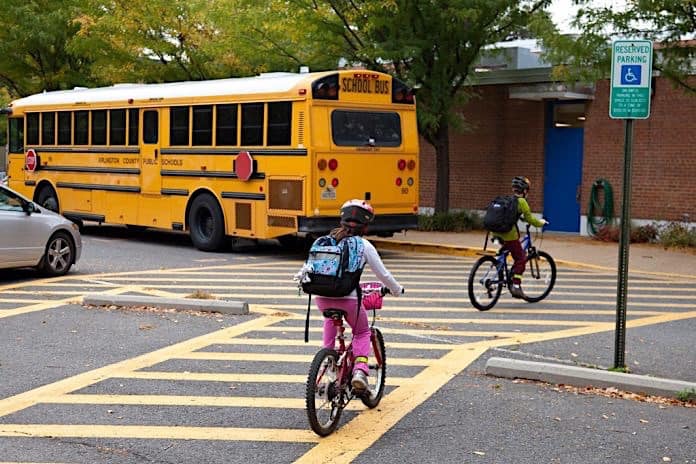A recent webinar by the Safe Routes to School National Partnership (SRTSNP) explores the options that transportation departments have for working with Safe Routes to School (SRTS) programs in order to ensure that children get to school safely.
The July 17 webinar was spurred by a recent report released by the SRTSNP called Buses, Boots, & Bicycles- A Look At How Safe Routes to School Professionals Can Collaborate With School Transportation Officials to Get Children to School Safely and Healthily. Speakers included Sara Zimmerman, technical assistance director for SRTSNP, Mike Martin, executive director for the National Association for Pupil Transportation (NAPT), and Bob Young, director of transportation for the Boulder Valley School District (BVSD) in Colorado. Young presented on Safe Routes to School at the STN EXPO last year.
Zimmerman started off by discussing how at first glance, SRTS supporters and school transportation staff and proponents may appear to be directly at odds, with one side promoting increased walking and biking to school, and the other promoting transportation via bus. However, she added that both sides share the mutual goals and interests of getting students to school safely, reducing the numbers of cars near school zones and promoting traffic safety skills for children. With these commonalities in mind, there is potential for collaboration, Zimmerman said.
She also listed a few potential goals for partnerships between transportation departments and SRTS, such as ensuring that streets near schools are safe, school buses offer pick-ups at centralized locations, as opposed to having various stops, and schools and local government mobilize to address hazards present near schools.
NAPT’s Mike Martin also emphasized the importance of SRTS and transportation departments working together on common goals.
“It seems to me these people should be natural partners but it hasn’t always worked out that way. And that needs to change,” he said.
Martin offered suggestions for transportation staff and others looking to get involved with developing new partnerships, such as reading or rereading the report that inspired the webinar and sending it to local transportation directors and asking how to get involved.
The last speaker was Bob Young, director of transportation for the Boulder Valley School District in Colorado. Young discussed the systems and programs his district implemented that “operate under the SRTS umbrella” and encourage walking, biking, carpooling or riding the bus to school over riding in a family car. Some of these programs include the Bike Lesson and Safety Training program (BLAST), which takes instructors to physical education programs throughout the district to teach students about bike safety skills.
Another program called Trip Tracker offers students “incentive dollars” for getting to school through alternatives to the family car. The dollars can be redeemed at local participating businesses.
Martin added that the district has received numerous awards and grants for their work, such as two Congestion Mitigation and Air Quality (CMAQ) grants, 14 total SRTS grants (6 infrastructure grants, 8 non-infrastructure grants, and two Oberstar awards.
The webinar concluded with the speakers fielding questions submitted by the participants.
















